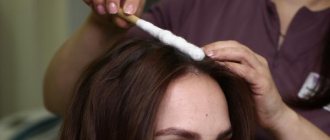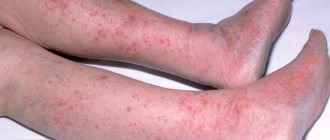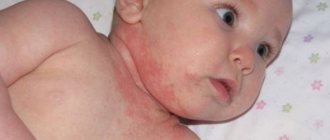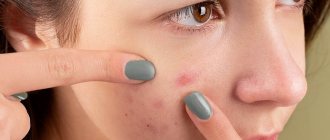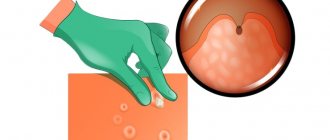Causes of papillomas
The cause of the appearance of papillomas in intimate places is the human papillomavirus (HPV), which circulates in the blood of almost every man and woman, starting from adolescence.
According to WHO, 80-90% of the population is infected with HPV. Most often, papillomas occur in young people who have a large number of sexual partners. Genital-anal papillomas are typical manifestations of human papillomavirus infection. In 90% of cases they are caused by the sixth and eleventh types of HPV.
In the daily life of every person, the following exposures increase the risk of infection:
- smoking;
- stress;
- using other people's hygiene products;
- visiting baths, saunas;
- shaking hands with carriers at the acute stage;
- decreased immunity.
Globally, the spread of HPV is influenced by many factors, including socioeconomic, medical, hygienic and geographic. The virus can stay in the body for years without showing itself. Its activation is provoked by a weakening of the protective forces of the immune system, which entails the appearance of papillomas in intimate places, both in women and men.
Pregnancy, hormonal imbalances, metabolic disorders, acute viral infections, long-term chronic diseases, poor nutrition and lack of sleep can also trigger the growth of papillomas in intimate places.
How can you effectively get rid of papillomas?
No pills or other medications will help get rid of all the above-mentioned tumors, which we conventionally called “papillomas.”
The only way is removal. Depending on the formation, this can be either a minimally invasive technique: laser coagulation, radio wave method, electrocoagulation, or surgical excision within healthy tissue with a certain indentation. Only a doctor can recommend the method of removal.
It is important to understand that the so-called “papilloma” is a small tumor of one nature or another, in most cases completely harmless from the point of view of the development of the oncological process.
Therefore, to the question: “How often do papillomas turn into cancer?” You can answer - most of the formations called “papillomas” are not dangerous, but only a doctor can give an accurate prognosis.
Routes of infection
Infection is possible not only through sexual intercourse, although this is the most common cause. HPV infection is also possible through household means:
- when using common hygiene and tableware;
- through contact with an infected person in the acute stage in the presence of microtraumas;
- the possibility of HPV transmission through household items is still being debated.
The transplacental route of infection is rare - from mother to child, even at the stage of intrauterine development of the fetus.
How to choose the right product
When choosing a specific drug, it is important to take into account the location of the papilloma, the exact cause of origin and the sensitivity of the skin. To decide on a treatment regimen, it is recommended to consult a specialist, since there are other skin diseases similar to papillomatosis.
Correctly chosen therapy will help to easily remove the formation without causing significant harm to the body. Tumors that are located on the mucous membranes require special attention. When choosing remedies in this case, it is necessary to take into account the sensitivity of this part of the body in order to avoid negative consequences.
Independent selection of drugs is undesirable, but is acceptable if you have personal knowledge and skills that help establish the benignity of the neoplasm.
Probability of infection
Women and men have an approximately equal risk of becoming infected without knowing it at all, since the peak of infection occurs in adolescence and older, when alertness to herpesvirus, papillomavirus, and HIV infection decreases.
At the same time, more attention is paid to sexually transmitted diseases, which, however, are also characterized by high dynamics of infection.
The number of sexual partners remains an important point, since today more than 190 types of HPV have already been described and every year there are more strains of the virus. The International Agency for Research on Cancer identifies 12 strains that are associated with the development of cancer of various locations:
- cervix;
- vulva;
- vagina;
- anal canal;
- penis.
By choosing the smallest number of sexual partners, the risk of becoming infected with HPV, including its oncogenic strains, is significantly reduced.
It is necessary to remember about personal hygiene, as well as the existence of vaccination, which reduces the risk of developing HPV by 95%. It is more effective to vaccinate before the age of 14 years, but up to 25 years of age is also possible. The vaccine provides the greatest protection if it was administered before the onset of sexual activity.
Symptoms
If there are papillomas in intimate places, symptoms are divided into subjective (sensations, complaints) and objective (which can be directly seen by a specialist). Subjective ones include:
- the presence of growths (single or multiple);
- spots on the skin and mucous membranes of the genital organs;
- itching and other unpleasant superficial sensations in the affected area;
- pain during sexual intercourse;
- if male papillomas in intimate places are located in the urethra, burning and painful itching and difficulty urinating may be observed.
The pathology is characterized by the presence of painful cracks and bleeding of the skin and mucous membranes.
Objective symptoms include:
- rashes;
- papules and spots;
- wart-like papillomas;
- pointed condylomas localized in the perineum and perianal area.
Folk remedies
In folk medicine, there are many recipes that have antiviral activity.
Potato juice
It is recommended to drink 100-200 ml of potato juice every morning. This folk remedy can also be applied to papilloma.
It helps strengthen the immune system and improve the condition of the body.
Celandine
For treatment, juice or tincture of celandine is used. The plant is rich in acid, which destroys papilloma cells.
To do this, celandine juice should be applied pointwise every 2 days, avoiding healthy skin.
Iodine, aspirin, boric acid
To prepare the product, mix 3 g of iodine with the same amount of aspirin, alcohol and boric acid. This composition should be regularly applied to the papilloma.
The product cannot be used on eyelids and mucous membranes.
Garlic
Recipe 1:
- Chop the garlic and add to a small amount of baby cream.
- Apply the paste to the formation and secure with a gauze bandage.
- Wash off after 2 hours.
- Repeat 2 times a week.
When the papilloma darkens and falls off, it is recommended to apply the product once every 3 days for another month.
Recipe 2:
- Take equal amounts of garlic and linden or flower honey.
- Chop the garlic and mix with the beekeeping product.
- Apply the composition to the papilloma for 20 minutes.
- Rinse off with warm water.
- Repeat the procedure 2 times a day until the tumor is rejected.
Recipe 3:
- Grind a whole head of garlic on a grater.
- Add 2 tbsp. l. pork fat, mix.
- Apply to papillomas 2 times a day and leave for 3 hours.
- Secure the composition with gauze or bandage.
The effect can be observed after 2-3 days - dead cells will disappear, the papilloma will begin to shrink.
Ointments and creams using garlic should not be used on mucous membranes and genitals. Otherwise, the mixture will cause burning, swelling and irritation.
If a month after the start of therapy no effect is observed and the growth has not decreased, it is recommended to consult a specialist.
Diagnostics
In order to more reliably determine whether the neoplasm belongs to anogenital warts, a test is carried out with a 5% solution of acetic acid, after treatment with which papillomas in intimate places retain a grayish-white color with a changing, intensifying vascular pattern of normal skin. Laboratory tests can also be used in diagnosis - identification of the HPV genotype with a prognosis for the course of the disease.
To diagnose precancerous conditions against the background of papillomas in intimate places in women, consultation with an obstetrician-gynecologist and urologist is recommended when papillomas are localized in intimate places in men, for example, with intraurethral localization. If there are papillomatous processes in the anal area, consultation with a proctologist is recommended.
What will happen to the skin after papillomas are removed?
The next day after the procedure, a brown crust forms at the site of the removed tumor. Healing takes from 2 to 7 days, it all depends on the size of the removed papilloma. After healing, the crust will come off on its own. The main thing at this time is not to wet or injure this area.
After the procedure, the doctor gives some simple recommendations for further skin care.
In our clinic, it is carried out using modern equipment by highly qualified doctors, which allows us to solve problems of papillomas removal quickly, efficiently and safely. We use disposable consumables, which guarantees maximum patient safety.
Treatment
To the question of how to treat papillomas in intimate places , modern medicine gives a clear answer: they need to be removed. Destruction of benign neoplasms can be carried out using various methods:
- electrocoagulation – exposure to high frequency current;
- cryodestruction - removal using cold treatment;
- laser removal – layer-by-layer treatment with laser radiation;
- chemical destruction - using special chemical solutions.
Classic surgical removal is also an option.
A specific scheme for how to completely and safely remove papillomas in intimate places is prescribed by a specialist in accordance with the localization of the process, the severity of the course, and concomitant diseases.
An important aspect of treating papillomas in intimate places is changing lifestyle and strengthening the immune system. An integrated approach avoids the emergence of new formations.
Papillomas on the neck
Pharmacy remedies for papillomas
A gentle way to reduce the activity of skin growths caused by HPV is the use of ointments and gels with special compositions. The products are applied pointwise to the wart itself and adjacent skin.
It is important that independent use of skin products can lead to complications of the disease, so only the attending physician can prescribe them. External medications are included in the complex therapy regimen and can be used throughout the entire period of therapeutic treatment.
The most popular and effective external means of combating papilloma on the neck are given below.
Panavir.
The gel contains plant components that are active against HPV. The concentration of active ingredients reaches a maximum after a week of regular use. The product can fight papillomas.
Viferon.
The immunomodulatory and antiviral properties of the drug allow it to be used as an effective means of combating the manifestations of HPV.
Oxolinic ointment.
The drug prevents the appearance of new skin growths and has a depressing effect on existing ones. Safe for pregnant and lactating women, children and teenagers. The mild effect explains the long course of use. Papilloma on the neck will disappear no earlier than after two weeks of daily use.
Salicylic ointment.
The product has antiseptic and anti-inflammatory properties. Can be used to combat papillomas.
Aldara cream.
The active substance can destroy the formation and dampen the intensity of the external manifestations of HPV.
Gel Antipapillom.
It acts quickly: warts disappear on the third day from the start of use. Has exfoliating properties.
Vishnevsky ointment.
Anti-inflammatory, bactericidal, antiviral agent, safe for use and with a wide range of indications. Effective against pathological skin formations.
Malavit.
Anti-inflammatory properties allow the drug to be used to combat papillomas.
Zinc ointment.
Exfoliates dead skin areas, has drying and softening properties.
Preparations for the removal of benign tumors are easy to use and are quite effective as part of complex therapy. However, you should not hope that the wart will disappear using only ointments and gels. Only a doctor can assess the degree of manifestation of the disease in order to prescribe the dosage of ointments and gels for course use.
Correct therapy proposed by a dermatologist alleviates the external symptoms of HPV, but does not eliminate the need to remove tumors. An attempt at self-medication can lead to unwanted and even dangerous complications.
How to remove papillomas on the neck at home
Seeing a doctor when papillomas appear is mandatory, since only correct diagnosis will guarantee a positive result. Trying to deal with the problem on your own is most often unsuccessful. Even the use of potent alkaline agents (Superchistotel, Antipapillom, Dermavit, Lyapis) does not guarantee a complete cure, in addition, such a strategy is associated with the danger of skin inflammation, the formation of scars and cicatrices.
In everyday life, so-called folk methods of fighting papillomas at home are used. Their effectiveness has not been proven by official medicine, although the biological activity of the active ingredients is quite high. A list of the most popular means is given below.
- Fresh juice of celandine or homemade aloe.
- Tea tree oil.
- Iodine.
- Castor oil with soda.
- Fresh garlic mixed with any rich cream.
- Laundry soap.
The composition is applied pointwise to the skin growth from one to two times a day. The duration of use usually reaches two weeks, after which the tumor should disappear. Will this actually happen? There are no official statistics, so the decision to use such pseudo-medical methods to solve the problem is made by the patient himself.
However, it is important to understand that any neoplasm poses a potential danger and, if the disease develops unfavorably, can cause many serious problems. It is possible to injure the delicate skin on the neck, which can lead to the development of dermatological diseases, vascular pathology and other complications.
Meanwhile, attempts to get rid of papillomas with home remedies are ineffective and rarely lead to the disappearance of growths. Moreover, the disease may progress and new foci of pathological growth may appear. In any case, you will have to see a doctor, but after home “treatment” the disease will be advanced and will require more time and effort to heal.
You can get detailed information about methods for removing papillomas on the neck and effective complex treatment of HPV at the Galaktika clinic.
Consultation with a dermatocosmetologist is the key to successful treatment of neoplasms without negative consequences. Make an appointment
